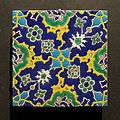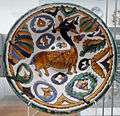Cuerda seca

Cuerda seca (Spanish for "dry cord") is a technique used when applying coloured glazes to ceramic surfaces.
When different coloured glazes are applied to a ceramic surface, the glazes have a tendency to run together during the firing process. In the cuerda seca technique, the water-soluble glazes are separated on the surface by thin lines of a greasy substance to prevent them running out of their delineated areas. A dark pigment such as manganese carbonate is usually mixed with the grease to produce a dark line around each coloured area.[1]
In central Asia tiles were manufactured using the cuerda seca technique from the second half of the 14th century.[2] The introduction of different coloured glazes is recorded in the mausoleums of the Shah-i-Zinda necropolis in Samarkand. In the 1360s the colours were restricted to white, turquoise and cobalt blue but by 1386 the palette had been expanded to include yellow, light-green and unglazed red.[3] Large quantities of cuerda seca tiles were produced during the Timurid (1370–1507) and Safavid (1501–1736) periods.[4]
In the 15th century Persian potters from Tabriz introduced the technique into Turkey and were responsible for decorating the Yeşil Mosque in Bursa (1419-1424).[5] Within the Ottoman Empire cuerda seca tilework fell out of fashion in the 1550s and new imperial buildings were decorated with underglaze-painted tiles from Iznik. The last building in Istanbul to include cuerda seca tilework was the Kara Ahmed Pasha Mosque which was designed in 1555 but only completed in 1572.[6][7]
 Tile from Khargird in Iran, mid 15th century
Tile from Khargird in Iran, mid 15th century Ottoman tile, Istanbul, first half 16th century
Ottoman tile, Istanbul, first half 16th century Pitcher from Susa in Iran, 8th-9th century
Pitcher from Susa in Iran, 8th-9th century Dish from Seville in Spain, early 16th century
Dish from Seville in Spain, early 16th century
Notes
- ↑ Campbell 2006.
- ↑ Porter 1995, p. 18.
- ↑ Atasoy & Raby 1989, p. 373, fn 23.
- ↑ Porter 1995, p. 20.
- ↑ Atasoy & Raby 1989, p. 83.
- ↑ Atasoy & Raby 1989, p. 220.
- ↑ Necipoğlu 2005, pp. 377-384.
Sources
- Atasoy, Nurhan; Raby, Julian (1989). Iznik: The Pottery of Ottoman Turkey. London: Alexandra Press. ISBN 978-1-85669-054-6.
- Campbell, Gordon, ed. (2006). "Cuerda seca and cuenca tiles". The Grove Encyclopedia of Decorative Arts, Volume 1. New York: Oxford University Press. p. 293. ISBN 978-0-19-518948-3.
- Necipoğlu, Gülru (2005). The Age of Sinan: Architectural Culture in the Ottoman Empire. London: Reaktion Books. ISBN 978-1-86189-253-9.
- Porter, Venetia (1995). Islamic Tiles. London: British Museum Press. ISBN 978-0-7141-1456-9.
Further reading
- Chapoulie, R.; Delery, C.; Daniel, F.; Vendrell-Saz, M. (2005). "Cuerda seca ceramics from Al-Andalus, Islamic Spain and Portugal (10th−12th centuries AD): Investigation with SEM–EDX and cathodoluminescence". Archaeometry. 47 (3): 519–534. doi:10.1111/j.1475-4754.2005.00217.x.
- Gestoso y Pérez, José (1899). Ensayo de un diccionario de los artífices que florecieron en Sevilla : desde el siglo XIII al XVIII inclusive. Volume 1 (in Spanish). Seville: En la oficina de la Andalucía moderna. p. 77. OCLC 9986104.
External links
| Wikimedia Commons has media related to Cuerda seca ceramics. |
- The cuerda seca method, Qantara project.